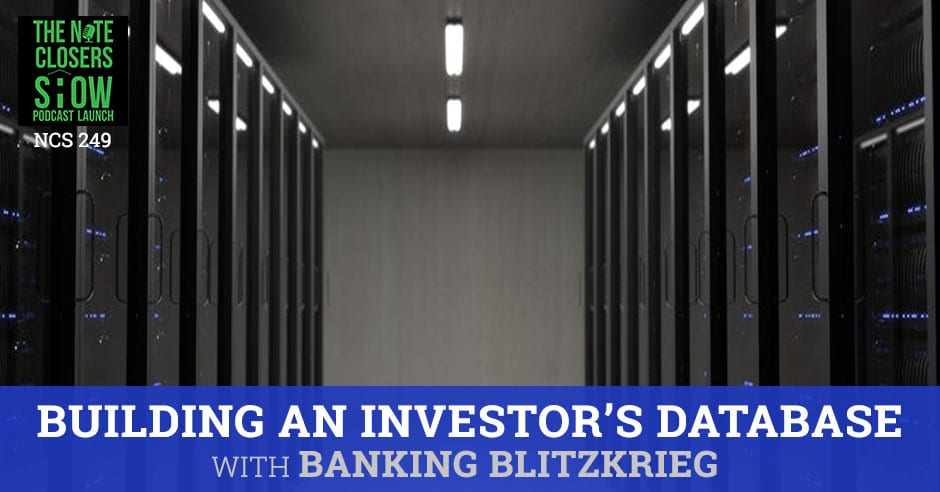
One of the most important tools a note investor has is a huge database that he can pull out leads from. Conducting phone calls, sending out emails and having a LinkedIn profile will help grow this database, but there is a faster way to this. Banking Blitzkrieg is an investors program hosted by We Close Notes that pools in 20 people who will be making phone calls to a list of asset managers on a regular basis, for four weeks. This sounds overwhelming if you are just starting, but the point of the program is not to get something right away, instead get something from it for the next six months or the rest of the year. Banking Blitzkrieg is a great way to start connections with people but it is very important to follow up on those connections. Learn the numbers that rounded up the Banking Blitzkrieg this year that will be leading to phenomenal results in the following months.
—
Listen to the podcast here
Building An Investor’s Database With Banking Blitzkrieg
On this episode, I thought I would share with you the results of our most recent Banking Blitzkrieg that we had. We had a four-week period from January 22nd through roughly the 16th of February. We’re reopening up to about twenty plus people. There are like 25 people to begin with and of course some people flaked off and ended up with right about fifteen people making phone calls on a regular basis for us over those four weeks. They call them and make their own lists. What happened is we literally pull the lists together and I separate the list off in chunks. That’s not always the easiest thing to do when you’re pulling from a variety of different places.
Some of the places that we pulled, we pulled from Lane Guide. I pulled from Texas Mortgage Bankers lists and then I pulled another list of my own as well that we had. Then I literally divvied up the lists at 100 asset managers at a time, 50 asset managers at the time. The goal was, the first week let’s get those callers 100 phone calls each. If they turn in the list, they’ll get a new list the following week. They’ve got to provide their call logs and that works really well for most of them, but we did have a few people that flaked off and those that didn’t complete their phone calls and flaked off, they didn’t get another list. It’s just not worth me doing the work on the frontend if they can’t do the simple work in the backend. I get it, 50 to 100 phone calls is not the easiest thing, especially if you’re brand new, but overwhelmingly along the way, a lot of people really enjoyed it.
One of the things is that we had done this a while back. We literally had gotten together over a year ago, maybe a year and a half ago now that I think about it in Anaheim with about nine to ten of our Mastermind members. We set out a week to make phone calls and knocked out a lot of phone calls. Not everyone is able to stay for the full five days. Some people were going to a different event, but those that stuck around, we are able to get about 2,000 phone calls made in that five-day period, which is really effective. Then we followed back up with reach outs and things like that and it’s prospered. Not everybody that showed up to that though followed up with that was the thing that concerns me. If all these people are going to do this work, we want to make sure that it’s relevant.
That’s one of the things that we promise those that went through this. “If you make all the way to the fourth week, we’ll make sure to give everybody the list,” and so we’re excited about that. We’ve got some amazing numbers. We’re finding an opportunity for the last couple of days to dive into it. We had over 5,036 different contacts and that’s a lot of phone calls. Over 5,000 phone calls over the four-week period. As far as individual names, at least first names, we’ve got over 3,900 names of asset managers. Now, you asked, that’s 1,100-name difference between having a bank name and actually having an asset manager. The thing you’ve got to keep in mind is not everybody’s going to be able to get through. That’s what happens. Some of the time people making phone calls and they fail to get in through. Out of those 3,900 names, the most valuable thing is we have 2,200 emails and that’s a really valuable aspect of things.
We’ll get 2,200 new emails to add to our database to reach out to. That’s phenomenal. I hope the fifteen people who made it through are going to continue to follow up with their phone call list. Now, they also have the list. Am I concerned that some people are going to call again? Not really, because honestly I’ll be surprised if everybody makes phone calls for longer than a month or two. It just is what it is. I hope they do. I literally hope they put this into their systems. I hope they use MailChimp or Infusionsoft or whatever and they start making phone calls on a regular basis. It’s one of the most valuable things that they’d be doing their business. I know that’s what we’re going to do. I know that once I get through Note Camp, we’ll have everything uploaded in the system and start rocking out with the regular emails. I’ve already got a pretty good sized that we’re already marketing on a regular basis, but we’ll be adding a new chunk to them as well and reaching out and going from there.
A lot of people were asking, “Did it merit any tapes?” We’re working through some assets, we’re working through tapes right now. We’ve got bids with tapes in. They are performing notes, not really my cup of tea, but we have a buyer submitted on it. We’re waiting to see back on what are available. We’ve made plenty of contexts with asset managers especially on the notes that say, “I don’t have anything this month but follow up next quarter or follow up next month.”That’s where the key is, in the follow up and that’s where most people, I’d say 95% of people fail is in the follow-up. They just don’t follow up. They get so busy, get so sidetracked chasing different squirrels, which is easy to do and then also life and they go from there. I think we learn a lot about ourselves when you’re making the phone calls.

Banking Blitzkrieg: The key is in the follow up. That’s where 95% of people fail. They don’t follow-up.
I think when sometimes we go to the least technologically savvy aspect of things and just dialing for dollars a lot of times. Realize that this is a very simple business and really that’s what this comes down to. Yes, you can have a lot of great marketing and you can have a lot of great autoresponders, click funnels, things like that, which is important and videos and training and stuff like that, but it’s all about getting people to connect with you. Now, the one thing I hadn’t figured out yet is I was asking people to go back in and figure out how many or try to connect with the people that couldn’t get a phone number or email, try to go back in and connect with those on their LinkedIn profile. I actually have a spreadsheet pulled up right here, I do custom sort here. We do it by LinkedIn profile, which is a great way to connect with people as well if you don’t have an email address. There are 1,300LinkedIn profiles which is a great way to add to your database.
That’s one of the best ways to reach out to asset managers is to connect with them directly on LinkedIn. Three ways to connect with them, email blast, phone number, and then also LinkedIn profile. One of the great things you can do is one of the things that we will do is take the list of emails and upload that list to Facebook for a custom audience. By just uploading the emails and see if those have a Facebook profile using their email address as their main email. Some do, some won’t. It’s probably going to be probably less than 30%, but that 30% on 2,200 names, that’s roughly 700 people I connect and market to on Facebook. That is a good thing to do things on a regular basis. Our whole aspect of things you keep in mind here is 80% of sales are made after the fifth contact.
That is a great thing to think about because most people won’t get to number five. They won’t get to their fifth email in a month. They won’t get to their fifth follow-up phone call. They won’t reach out the fifth time and touch somebody. That’s why it’s important that you develop some funnel campaign or marketing campaign to really funnel these leads. That’s exactly what we’re doing. We take the list and we’ll upload it to MailChimp, Infusionsoft, there’ll be a little bit of crossover. A little bit of duplicates on this is list, but not much. We’ll get clean lists that way. We’ll send a blast out. Now, the thing is important, whenever you upload a list of like 5,000 names or 3,000 emails or whatever it is, split that list up. The last thing you want to do is send an email out and have bad emails bouncing and kill your email service provider. They kill your account, which will happen if you’re using Constant Contact or iContact.
MailChimp in slapped on the wrist occasionally. It’s important to get that list cleaned up so those you have who are working emails are perfect so that you delete off the ones that aren’t working. It also helps you out to, to be able to view who’s opening your emails. The fact that we have a lot of names allows for us to customize those emails by putting their first name or last name and their email and their name literally in the email message with custom fields. Now, that’s a great way to get an extra couple of percentage points for people to open or a couple of percentage points higher on your open rates because people see their name and they’re like, “I’m going to click on this.” They open up.
The important thing to keep in mind is once you get them to open up that email, you want to try to get their attention quick because as you’ll hear me off and say now, we have an attention span less than less than a goldfish. Goldfish is nine seconds. We have an eight-second attention span, which I can see by people viewing and dropping off.
The important thing is have some image, maybe a video that people can click on it. I just wanted to say, “This is what we specialize in doing.” You want to have it short and sweet. You don’t want to have diarrhea mouth and throw up on them. You want to keep your email to really three or four paragraphs the most. Something short, concise, straight to the point, “Do you have anything on your books? Do you have anything ugly?” Those are the things to keep in mind when you’re out contacting asset managers. You want to be short, sweet and be respectful of their time. Are you going to have people that unsubscribe? Are you going to have people that don’t want to talk to you? Yes. What happens a lot of times though too is a lot of people will hold your email. Asset managers are in the process of building lists of note sellers and note buyers.
As you follow up with them on your third, fourth, fifth, sixth month of following up between now and August, the whole idea of this exercise for the most part is not to get anything right now is to get something over the next six months, over the next seven months, over the rest of the year. If we get anything in the first 30 to 60 days, by all means, that’s phenomenal. Anything that comes from those tapes that we have marketing, we’ll split the profits across to fifteen but after 30 days, it’s all in the follow-up. As long as marketing the list and they get a list that I don’t get, kudos to them. That’s why I’m a big believer that there’s enough to go around. Not everybody’s going to do that. 99% of note investors out there want something given to them. We had a guy on the Note Night in America webinars who said like, “Am I going to get a lists? Am I going to get directed to asset managers?” I’m like, “Not for $97 bucks a month, no. Notif you come to a class for $500. I’m not going to give you my asset manager list for $500.” It doesn’t work that way.
You have to be willing to work. If you’re not going to pay for a list, which lists like this is very, very valuable, if you’re not going to work for it, then you can’t expect to buy from the short end of the stick, to buy from the low hanging fruit that everybody else is going after. That’s why we came up with this big push because nobody’s doing it. Nobody’s separate themselves and that’s where we feel that we separate ourselves is by reaching out on this Banking Blitzkrieg. I will give periodic updates on what’s going on. I think it’s a regular thing will have. At least probably a discussion of what’s going on once a month with our marketing. That’s the biggest thing to keep in mind is I think a lot of people don’t do what we do and there’s an exception or two. Brecht Palombo with Distressed Pro, we have to get Brecht on here. We got to get him on an episode on the show to talk about Distressed Pro and his background. He does this on a regular basis.
The thing you got to keep in mind, you don’t need 5,000 sources. How many tapes came in? We had a two tapes come in, performing notes that we’re actually having a price out right now. We have an offer in on them and we’re presenting offer today to the two sellers and see if they’re interested in selling off their performing tapes because we have a performing buyer. We’ve got a few one off assets here and there. Some REOs that popped up that people are working on. We had a weird deal out in West Texas on a bunch of timeshare notes. The guy wanted to unload in a small little town. You shouldn’t be putting timeshares in a small Texas town. I didn’t expect to see the tapes but did great. It’s all about the follow up. It’s all about dropping an email out once a month sending that up to do business on a regular basis. You might be doing business is the actual business of reaching out to asset managers.
You don’t have to make 1,000 phone calls, you don’t have to make 100 phone calls in a week once you’ve got a list. Send it up once a month. First Tuesday of the month, send it out. Follow that email up two days later to the same email to people that didn’t open the first round of emails on opposite time. You sent your first two email at 11:00 in the morning, send the follow up on it to 2:00, 3:00 in the afternoon. If you can use something like MailChimp as your email service provider, MailChimp will allow you to set up a time warp. You could set it up 24 hours in advance of it going out. It’ll actually go out and identify the time zones of those emails and IP addresses and things like that and be able to allow you to send an email out as we need to send that 3:00 timeframe. A chunk at 3:00 Eastern all the way to 3:00 Pacific.
You’ll have four, five potential emails going out that hits their time zone and their optimal open times. It’s a great feature to have on a list like this. You’re going to need to have a paid version of an email service provider for the most part. MailChimp used to do. I don’t know if they still do it or not. They used to let you have up to 2,000 contacts before they start charging you. That’s not the case for the most part. It’s well worth paying for it. We’ll drop this into our funnel. There’s a whole variety of things on those that to communicate with us and stuff like that. We’ll be able to reach out to them on a regular basis. Send them a quarterly update, at least on what we’ve bought, what we closed on and we’ll go from there.
We have a question, “If you have a full time job, how many calls to asset managers should you target per week and be effective? Of course, you have to be consistently doing it along with your emails.”
I’m going to separate the two because your emails and your phone calls or different things that you do. If you’re using an email service provider like MailChimp and Infusionsoft, you can write your emails at night. You can write your email at night for autosender, schedule a time for it to go out. Your emails are different. If you’re working a full time job, I don’t know what your time frame is. If you’re working nine to five, you don’t really have a lot of time unless you’re doing it at lunch or right on the East Coast and then you start calling the West Coast. If you wake up early, if you live on the West Coast, you could wake up early and call on the East Coast. That’s a harder thing. That’s why I liked the LinkedIn strategy of going onto LinkedIn and contacting asset managers on LinkedIn because you knew that they’re in it in all hours of the day or the night. If you’re working a full time, 8 to 5 or 9 to 5, you’re going to knock that out. If you’re making phone calls during your lunch break, you’re going to have to do consistently to see any type of improvement. I tell people, “If you got two hours, you should be able to knock out at least 20 to 30 phone calls. That’s having a list preprinted and you’re just dialing for dollars.

Banking Blitzkrieg: If you’re an entrepreneur and you’re a real estate investor doing things, it’s your own butt, it’s your own money on the line.
I used to make phone calls in my truck especially if I was driving at a long commute, sit in traffic. I would have a print out that I would just dial while I was driving. I have it on speaker we call them that way. You don’t want to do that if you’ve got really crappy reception and it sounds like shit. It’s important if you’ve got an hour or an hour and a half, 30 minutes you’re not going to have a lot of time and it’s going to be hard to get around to doing it if you’re got to run an errand or two. Personally, if you’ve only got your lunch break, I’d probably wouldn’t make calling asset managers my strategy. I would say go in to LinkedIn and connecting with them on LinkedIn and then exporting those contacts and emailing those out would be more effective to you. I don’t know what your work is or if you’re in front of a computer, you can always answer those individually as they come in throughout the day and then set up a time if you need to call people back at lunchtime if you need to or take a break.
That’s what I would recommend for that aspect. Asset managers are just normal people like you and me. They may give you crap. You have to realize one thing, if you’re an entrepreneur and you’re a real estate investor doing things, it’s your own butt, it’s your own money on the line. Many asset managers, even the hedge fund guys, they’ve got a salary, they’ve got a job, they’ve got a cushion, a safety net to make things happen. Don’t ever feel intimidated with calling them because you’re calling on your behalf. You’re calling to offer them up an opportunity to actually offload their debt to you or you can take over the bank’s problems and create a true win-win.
If you’re listening on iTunes or Stitcher, I want to say thank you again as always for listening. We’re glad to have you. I’m so proud of the fact that we went over a 70,000 downloads on the podcast. It was exciting in under seven months. Just over a six months timeframe, which is exciting to see definitely with that aspect of things. How often should you update your list? That’s an important thing, because in most cases you’ll probably get around a 20% open rates. Hopefully, the first couple of emails, you’d probably get close to a 30% to 35% you’re sure the email is being accurate. You wish it was more. Sending that follow up email a couple days later should ensure another 5% to 12% open rates depending on where they hit. That’s maybe somewhere between 25% and 40% open rate. That’s a phenomenal aspect. Now, if you keep sending that lists out on a regular basis and on a monthly basis, you’ll get a few more percentage points.
We have a question, “When will the Banking Blitzkrieg save the database?”
I have already uploaded at the Basecamp group. If you’re part of Banking Blitzkrieg, there’s twenty people. Not everybody’s going to get that. Only a chunk of people will see that. If you follow, you’ll probably at some point you’ll have some people open the email up the second or third time who didn’t open the first time. You’ll get some people that will opt out. You get some people that just never opened the email. It is what it is. That idea to keep in mind is that at some point if you stick with it long enough, three, six, nine, twelve months of emails, eventually people will respond and they’ll start seeing your emails and you’ll be branded into their brain.” There is that note gal or there is that note guy. I need to send them some stuff or I got something on my books or I got something negative. I wonder if this guy or this gal keeps emailing me monthly is interested in buying this asset.”
That’s what you want. We have seen that time and time again over the last couple years of people when we send an email up like, “I have something finally for you.” I’ve been to different conferences, the Mortgage Bankers Association, Servicing Conventions, whatever and people have come up to me and said, “You’re that guy I get an email from. I just wanted to come up and say thank you. I love your marketing.” Or, “You’re that guy? I keep getting emails from you.” You know what they usually say, “I always say, great. If you don’t like it, you’re going to have to unsubscribe.” “No, no, no. I liked the information. I liked seeing what you’re doing.” That’s the thing ultimately we have to keep in mind everybody. We’re constantly in a marketing phase.

Banking Blitzkrieg: If you’ve never sucked at something, you are so lying and you need to go get help because everybody sucks.
You as entrepreneurs, you as real estate investors you’re constantly marketing to better yourself, to find deals, and an asset manager list is never going to be harmful for you to do. It’s something that will be valuable for the long run. Building and honing your craft or write an email or create a marketing piece, you’re going to suck at it first. Everybody sucks at first. You want to keep in mind the idea of embracing the suck. If you’ve ever done that and gotten better, you could give me that #EmbraceTheSuck. If you haven’t, you’re lying. If you’ve never sucked at something, you are so lying and you need to go get help. You need to check yourself into liars anonymous because everybody’s sucks when you start off. I have sucked at so many things and the only thing and the reason I’ve gotten better at so many things is that we stick to it. I don’t focus on my weaknesses, I focus on my strengths. You’re going to get better, you get better at things over time. You just have to work at it and continue to work at it and hone your skills and get better and better and better.
We have a question, “Scott, can I hire virtual assistant? Can I hire someone from overseas, the Philippines to dial for dollars?”
You can. There’s nothing saying that you can’t. I just don’t think it’s an effective use of time. Don’t get me wrong. If someone speaks really fluent English, that’s great. If you can set that up, good. Do it. Those that don’t speak good English, you just don’t want him to do it because it’s going to burn bridges more than anything else. It’d be a waste of time when they’re not properly sharing information. I know several people that have hired Philippines call centers and they’re doing that. That’s phenomenal. That’s great. You want to make sure you give them a script and coach them through things because they’re not going to be good at it right off the bat. They’re going to suck a little bit. You just have to spend time coaching them. That’s one of the big things that has helped is the use of scripts and things like that. We’re going to dabble a little more into the Banking Blitzkrieg, a little bit this week and as well talking about some of the things that we did and helping people go through that initial phase so that if they want to start calling asset managers, they can and they can be effective at it.
I was very pleasantly surprised of the number of phone calls and the contacts. I see a few duplicates of people included call outs but that’s completely fine. We’ll get that cleaned up relatively easy when uploaded into our CRM tool and we combine contacts together. I just wanted to share the Banking Blitzkrieg results and what’s happened and the effectiveness of it right now. It’s not something I knew that we would have instant gratification from and I shared that with everybody as they were going through it. I was like, “This is probably not going to be something that works in the first 30 days or 60 days, this a long-term thing. The biggest value you’re going to get is you’re going to walk away with a very valuable list that if you use it, great. You’ll find success over the long run. If you don’t use it, shame on you. This is not for you.”
That’s the big thing you keep in mind when calling asset managers. It’s not something that’s going to happen like that. If you do it every week, day in, day out, set aside two days or a day or a couple hours each night to jump on LinkedIn or other things to find asset managers, you’ll find success. It just takes time and that’s what building a business is all about. You want a flash in the pan, you want to put some dedication and some marketing, some follow work, and you’ll often put a lot of stuff in and you’ll get some really valuable stuff on the other side. Go out. Make something happen. If you’re dealing with something you’re struggling, go out and make it happen and we’ll see you all at the top.

